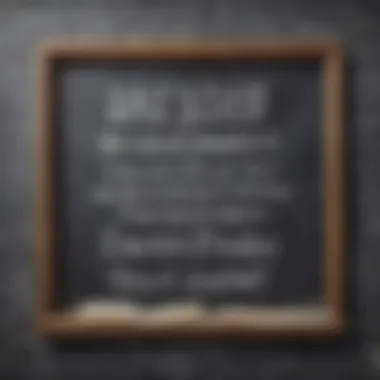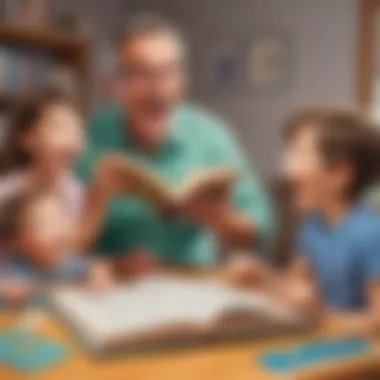Exploring the Joy of Bad Dad Jokes: A Guide for Educators


Intro
Bad dad jokes are a special type of humor, renowned for their simplicity and predictably cheesy punchlines. These types of jokes have carved a unique niche, especially in the realm of elementary school humor. While they may seem unbearably silly to some, they are an essential tool for bonding and learning through laughter. This article unveils the essence of these jokes, illustrating their cultural significance and appeal among children. We also present practical examples that educators and parents can confidently use within and outside the classroom setting.
The charm of bad dad jokes often lies in their awkwardness and groan-inducing results. But not only do they bring laughter, they can also foster social interactions and emotional learning. Let us move further into the realm of Creative Activities that integrate this whimsical form of humor, making educational experiences memorable for children.
Creative Activities
Engaging children creatively can enhance their understanding and appreciation of humor. Here are some activities tailored to exploit the allure of bad dad jokes.
Craft Ideas
Creative crafts based on bad dad jokes can be fun and meaningful. Children can craft joke cards or funny hats featuring different punchlines. This encourages not just humor but creativity. They could even create a joke wall to display their favorites, combining visual art and comedy.
Step-by-Step Guides
- Joke Card Creation: Provide index cards and let kids design their own joke cards complete with colorful images to represent their humor.
- Funny Hat Crafts: Using paper plates or construction paper, children can create hats. They might add visual elements that represent silly jokes like ‘‘I’m on a seafood diet. I see food and I eat it.’’
- Joke Wall Layout: Assign a wall space where each child can post their funniest creation. You could guide them in decorating this spot to look bright and inviting.
Educational Value
Engaging in these activities contributes to multiple learning dimensions. They help children refine their fine motor skills and enhance their language proficiency through creative expression. Additionally, children practice listening and comprehension skills when someone shares a joke, promoting active participation in conversations.
Fun Quizzes
Quizzes that interlace humor with learning make an entertaining blend for busy classrooms.
Quiz Topics
Consider organizing quizzes on things like science facts, math riddles connected to dad jokes, or history figures known for their humorous traits. These topics help make dry subjects more relatable and exciting.
Question Types
Using various question styles can maintain students' engagement. Multiple-choice, fill-in-the-blank, and true/false questions could all be elements of these quizzes.
Knowledge Reinforcement
Quizzes not only refresh memory but offer reinforcing prompts for lessons learned. They can bridge the gap between factual learning and humor, making information easier to remember.
Fact-Based Articles
Accessing well-researched articles about the psychology of humor or famous comedians can amplify a child’s understanding of the cultural ramifications of comedy.
Topics
Discussion on classic comedians or humor's evolution in society could engage young minds beautifully. These topics may intrigue children and tempts them to explore.
Engaging Content
Fact-based articles should present information clearly, with fun trivia or eye-catching illustrations. This engagement rewards kids for seeking more knowledge.
Understanding Bad Dad Jokes
Understanding 'bad dad jokes' is crucial for diving into their cultural significance and appeal among elementary school children. These jokes have a unique humor style that connects easily with kids—simplistic, often based on puns, and can transport them into a lighthearted atmosphere. This section examines various elements that contribute to the value these jokes hold.
Definition of Bad Dad Jokes
Bad dad jokes generally consist of short and straightforward one-liners, often involving puns or plays on words. Theirsimplicity is what captivates younger audiences. Each punchline tends to induce groans from listeners rather than belly laughs. This aspect plays to the charm of the joke; the unbearable punning creates laughter in the realm of humor, typically appealing to kids who relish simplicity and repetitive beat of jokes.
Examples include:
- What do you call cheese that isn't yours? Nacho cheese!
- Why don't skeletons fight each other? They don’t have the guts.
These jokes illustrate the basic structure of bad dad jokes, where the humor is evident, though not particularly sophisticated. The charm lies in their ability to straddle the line between funny and cringeworthy.


Historical Context
The history of dad jokes ties to father figures expressing love and connection through humor. The term 'dad joke' emerged around the late 20th century, reflecting the era’s emphasis on family and interconnectedness. This context heightens their relevance today, as many families continue to share these light-hearted exchanges at home. These exchanges often happen at the dinner table or during downtime activities like family game nights.
Through the lens of culture, bad dad jokes represent the shared experience between parents and children. They are not just jokes; they grow out of a tradition of oral storytelling where parents engage their children in playful banter. These moments carve pathways for deeper relationships, making the laughter unforgettable. In classrooms, teachers can harness this humor culture to create memorable learning experiences. As education evolves, exploring the roots of dad jokes becomes a useful framework for understanding their lingering impact.
“Bad dad jokes foster an atmosphere of warmth that encourages communication and engagement, vital in both homes and learning environments.”
Characteristics of Bad Dad Jokes
Bad dad jokes hold a unique place in humor, especially for elementary school children. This type of humor is characterized by its light-heartedness and simplicity, which can ease social interactions. Understanding their characteristics is vital, as it highlights how these jokes function and resonate with young audiences.
Puns and Wordplay
One of the major characteristics of bad dad jokes is the use of puns and wordplay. Puns play with the multiple meanings of words, making them clever yet often groan-inducing. For example, a classic joke might go, What do you call fake spaghetti? An impasta!
This style of humor captivates children. It gets them to think about language in a fun way and encourages imagination. The laughter that follows often strengthens the bond between the joke teller and the audience, creating enjoyable moments in daily life.
Through puns, kids learn about the flexibility of language. Classroom discussion can include the exploration of word meanings, bolstering their vocabulary in an engaging context.
Simplicity and Directness
Another clear trait of bad dad jokes is their simplicity and directness. Most jokes are straightforward and concise. Children are more likely to appreciate jokes they can quickly understand. For example, a simple question and answer format—Why did the bicycle fall over? Because it was two tired!—is effective because it connects relatable scenarios with humor that doesn’t require deep analysis.
This direct approach makes it accessible for younger audiences, allowing them to absorb and share the humor easily. As a tool for conversation, simple jokes can enhance children's confidence in their social circles. Noticing what makes others laugh helps them navigate emotional landscapes better.
In summary, the characteristics of bad dad jokes centered around puns and simplicity make them effective tools for both humor and engagement among children. They foster learning and creativity in a fun format, appealing to not just children but also adults who appreciate the charm of these lighthearted jests.
Psychological Appeal of Humorous Content
Understanding the psychological appeal of humorous content, especially bad dad jokes, is essential for recognizing their influence in educational settings. These jokes not only provide amusement but also deeply engage children's cognitive and emotional development. Humor functions on multiple levels, serving as a social tool for communication and fostering a sense of belonging among peers.
Cognitive Benefits of Laughter
Laughter is a universal language, and it carries cognitive benefits that can't be overlooked, especially in children. When children laugh, it sparks something significant in their brains. Here are some of the benefits:
- Enhancement of Creativity: Engagement with humor encourages divergent thinking, leading children to explore various solutions to problems creatively.
- Stress Relief: Jokes provide a quick escape from stress or anxious feelings. For young learners, ligh-hearted humor creates a safe and relaxed environment.
- Boosting Problem-Solving Skills: The nature of bad dad jokes often involves twists and unexpected punchlines which stimulate critical thinking.
- Encouragement of Social Interaction: Laughter brings children together, enhancing their social skills through shared jokes and experiences.
“Laughter is a natural high that children can experience in even simple moments.”
In adapting jokes for classroom use, educators can take advantage of these cognitive benefits to enhance the learning experience.
Humor and Memory Retention
Using humor, particularly through bad dad jokes, has shown to significantly improve memory retention. The amusing element of a joke embeds the content in a more memorable way. Here’s why it works:
- Emotional Connection: Funny material elicits an emotional response, which increases memory retention compared to dull material. Emotions play a key role in how memories are formed and retrieved.
- Breaking Monotony: Jokes introduce a distraction from structured learning, creating a more enjoyable atmosphere. This interruption can serve as a mental reset, making students more receptive to learning.
- Association: Integrating humor with academic concepts helps children associate new information with something fun, creating an easily recallable link later.
- Repetition through Humor: Jokes often involve repetition of key words or themes, helping reinforce learning through repeated exposure.
Incorporating bad dad jokes into lessons could effectively promote an engaging environment. By doing so, educators can harness the dual effects of enjoyment and enhanced memory, which in turn supports a more thriving educational outlook.
Creating Bad Dad Jokes
Creating bad dad jokes is essential to understanding their appeal in various settings, especially for elementary adventures. These jokes combine education and entertainment, engaging young children. They build a bridge to learning by making it easier for kids to participate and relate. Through humor, educators can create a more enlivened atmosphere and foster meaningful connections among students. A successful bad dad joke promotes laughter while enhancing cognitive skills like listening and processing information.
Structure and Format
The structure of a bad dad joke often adheres to a brief and straightforward format. This simplicity makes them easily digestible for children. Typically, a joke consists of a setup and a punchline, sometimes culminating in a surprising twist or pun. This structure facilitates comprehension and retention among elementary school children. Here are some elements of joke structure:
- Setup: This is where the premise is introduced. It sets the stage, creating anticipation.
- Punchline: The punchline delivers the humor, often with a play on words. It should be unexpected yet relevant to the setup. This sudden shift elicits laughter.
For instance, consider the following joke:
Why did the scarecrow win an award? Because he was outstanding in his field!
Here, the setup invites curiosity, and the punchline utilizes a clever pun. The straightforward nature of this joke illustrates how effective this structure can be in resonating with kids.
Topics and Themes
Selecting topics for bad dad jokes often revolves around themes that resonate with children. Popular subjects include animals, school, holidays, and everyday experiences. Such themes are familiar to children's lives and offer relatable context.
When choosing topics, consider the following:


- Animals: Jokes relating to pets or wildlife can engage children's innate curiosity.
- School Life: Clever humor about teachers, homework, or classroom situations is effective as it confronts their daily experiences.
- Seasonal Themes: Tying jokes to holidays creates a special connection. It evokes the joy linked with celebrations, making them memorable.
Example topics could be:
- Springtime adventures with gardening joke.
- Back to school anecdotes for a humorous take on learning.
These vibrant topics build familiarity, nurture understanding, and contribute to good-natured humor. Crafting bad dad jokes using these foundations enriches the humor experience, making it enjoyable and constructive for all.
Examples of New Bad Dad Jokes for Kids
Understanding what makes a new bad dad joke valuable for children entails more than just laughter. These jokes often serve as gateways to creating warm connections in an elementary learning environment. Engaging with such humor can foster creativity, assist in coping with pressure, and even improve communication skills among peers. By introducing elements that resonate well with kids, educators and parents have the chance to enhance interaction and collaboration.
Humor can break the ice, reduce tension, and promote healthier relationships in educational contexts.
Classic Formats
Classic formats of bad dad jokes often rest on simple structures that most kids find appealing. These formats typically consist of a set-up followed by a punchline, offering predictability that children can relate to. This structure is effective because it builds anticipation and a sense of fun within the joke-telling process. Examples include:
- **
The Role of Humor in Education
Humor plays a significant role in education, and this aspect cannot be overlooked in the context of bad dad jokes. What makes these jokes appealing to elementary school students is their simple structure and humorous twist, allowing for moments of levity that can foster a love of learning. Notably, humor can fit seamlessly into the educational experience, enhancing engagement and retaining attention in an often demanding classroom setting.
Enhancing Engagement
Incorporating humor into lesson plans can significantly enhance student engagement. It breaks the ice and helps create a more dynamic classroom environment. Bad dad jokes, with their predictable punchlines, invite students to participate without the risk of making serious errors. This encourages a playful nature that helps maintain student focus. When students laugh, their brain releases chemicals like dopamine, which can improve mood and enhance motivation for learning. Research indicates that laughter can make learning more enjoyable, and preferences for humorous approaches can improve retention of knowledge. Teachers can ask students to share their own jokes, making them more involved.
Key Benefits of Using Humor
- Increased Attention: Laughter draws student focus, aiding better listening skills.
- Enhanced Memory: Jokes associated with learning materials can improve retention.
- Cognitive Development: Humor encourages creative thinking and exploration of ideas.
Fostering a Positive Classroom Environment
Humor, especially through bad dad jokes, successfully contributes to a nurturing classroom atmosphere. It promotes social bonding among peers. When students share laughs, it can diminish social barriers. Kids who share jokes feel less isolated, augmenting a sense of community. This sense can be especially valuable for those who may struggle with social interactions.
Advantages of a Positive Environment
- Stronger Relationships: Humor builds connections between educators and students.
- Reducing Anxiety: A humorous comment can alleviate stress during difficult assessments.
- Improved Class Dynamics: Humor can pave the way for a more cohesive group.
Incorporating bad dad jokes can create a jovial atmosphere conducive to learning.
Using humor effectively necessitates a balance. Not all humor reaches every student, and awareness of individual differences is important when integrating jokes into lesson plans. Nonetheless, the right approach can yield richer academic landscapes.
Balancing Humor and Appropriateness
The integration of humor in educational contexts must be approached with careful consideration. The application of bad dad jokes, specifically, requires a balance that caters to the sensitivities of young audiences while fostering an environment conducive to learning. This segmentexplores the important elements that constitute this balance, presenting an overview of how humour can be utilized effectively.
Age-appropriate Content
Understanding what makes content suitable is vital when using humor in a classroom. The jokes selected must align with the cognitive and social developmental stages of elementary school children. Participants in this age range typically appreciate simple language and clear punchlines. Using jokes that require sophisticated understanding can lead to confusion rather than enjoyment.
In crafting jokes for this demographic, it is advisable to consider:
- Language Complexity: Avoid elaborate phrases or jargon unfamiliar to children.
- Themes: Focus on common childhood experiences, familiar animals, and other relatable topics. This assures that the references resonate with the child's existing knowledge.
- Emotional Reactions: Always gear jokes to elicit smiles and laughter, not discomfort or embarrassment.
Measuring appropriateness is essential, as inappropriate humor can affect children negatively. Teachers should feel comfortable presenting these jokes to ensure that they compliment the learning experience.
Cultural Sensitivity
Cultural context shapes humor significantly. Different cultural backgrounds influence what is deemed funny or acceptable. A joke that is entertaining for one group might not be perceived the same way by another. Incorporating culturally sensitive jokes ensures inclusivity in a diverse classroom.
In this regard, it is pertinent to:


- Research Backgrounds: Knowing the demographic makeup of the classroom can help in selecting jokes that are respectful to various cultures.
- Promote Understanding: Select humor that encourages knowledge, respect and dialogue about different traditions and ways of life, reducing the risk of offending anyone.
- Be Informed on Current Events: A joke reflective of cultural content should be relevant. Awareness of current issues can be llestial for fostering a more educated and open-minded environment.
Humor, when used wisely in diverse cultual settings can enlighten students by educating them about differences while bridging important gaps.
If the balance of humor and appropriateness is maintained, bad dad jokes can sarve as not merely a comedic escape but also an effective educational tool to enrich children’s learning experiences.
Incorporating Jokes in Learning Activities
Incorporating bad dad jokes into learning activities serves as an effective strategy to enhance engagement and foster a joyful learning atmosphere. Using humor—particularly puns and playful language—can facilitate a safe environment that nurtures curiosity in elementary students. Humor can draw children's attention, making content memorable and enjoyable, ultimately aiding the natural learning process.
Games and Collaborative Activities
Adding jokes to games can create an immersive experience for students. These games can center around various subjects, from science to literature, making essential skills came alive. For example, a trivia game combining fun facts with pun-weighted questions can stimulate minds. Everyone enjoys moments of laughter, and integrated jokes makes the competition less intense.
- Example Activity: Organize a scavenger hunt where clues are riddled with dad jokes. Create hints like: What do you call cheese that isn't yours? Nacho cheese! This way, children remain engaged while receiving relevant questions about a subject.
Collaborative activities encourage team dynamics. Teamwork is an indisputable skill in a school setting. Goals paired with humor offer breaks from learning intensity. Riddles and joke-presentation games enable students to unveil creativity and develop presentation skills with camaraderie providing support. Not just humor, but collaboration itself determines robustness in education.
Storytelling and Presentation Skills
Storytelling is an art with significant impact. Combining storytelling with humor solidifies narrative comprehension and speaking confidence. Children often enjoy sharing funny experiences, allowing them to build simple sentence structures and extend vocabulary. Encouraging students to incorporate jokes into storytelling proves beneficial, enriching tales sheened with laughter and vividness of youthfulness. Children learn how to thrive in expressions where they can feel light-hearted, simultaneously constructing sentences around humor, fostering confidence in their presentation abilities.
An exercise like this may involve students creating a short skit around assigned topics. Each participant can introduce a memorable line from their tale, making an effort to invoke laughter. Presentations seem often daunting, but adding humor eases tension thus enhancing comfort.
Feedback From Students
The topic of feedback from students is essential in understanding the connection between bad dad jokes and their impact in educational settings. Feedback serves several important functions, from evaluating engagement to assessing the enhancement of social skills among elementary school children. Additionally, it highlights how humor integrates into the learning process. The inclusion of bad dad jokes in class activities can create a more relaxed atmosphere, making students feel more at ease.
Impact on Student Engagement
Student engagement is a critical factor in educational success. Feedback from students often reveals their level of interest and attentiveness in learning experiences heightened by humor. Bad dad jokes can serve as an effective tool to break down communication barriers between teachers and students. When jokes are used appropriately, they captivate students, encouraging participation.
Humor encourages interaction, lightening the overall mood and motivating kids to join in discussions or activities. When a teacher shares a joke that resonates with students, it acts as an icebreaker. This can lead to a more dynamic classroom experience where students are not afraid to express their thoughts. However, the key is to gauge the jokes correctly in relation to their age group and understanding.
Humor can push students to connect on a social level that often leads to enhanced classroom participation.
Empathy and Social Skills
Another aspect that feedback sheds light on is the development of empathy and social skills among students. An environment infused with humor helps children learn to read emotional cues and respond appropriately to their peers. Bad dad jokes create moments of shared laughter, fostering connections between children.
As students experience humor, they often develop a sense of belonging. They gain practice in recognizing diverse reactions to jokes, which comfronts them to develop empathetic responses. Thus, bad dad jokes become tools not only for entertainment but also for social development.
Incorporating slees types of humor helps teach students the value of playful banter and how humor can relieve tension. Understanding humor can catalyze peer interactions and help resolve conflicts in a constructive manner, promoting inclusive behavior. The analysis of student feedback reveals how vital bad dad jokes are in developing these essential emotional competencies.
Culmination: The Value of Bad Dad Jokes
The exploration of bad dad jokes reveals their unique significance in education, especially within the context of elementary school learning. Their simplicity, relatability, and timing make them both engaging and approachable for children. One jouke may elicit giggles, while another enhances social connections among peers. Learning through humor positions the classroom as not just a space for academics, but a place where fne friendships can form and where risk-taking is mere play.
Key elements of bad dad jokes ought to be recognized, notably how they lighten discussions and relatlionships between teachers and students. These jokes encourage an atmosphere of openness. Kids often understand that humor, even if silly, has a place within educational settings. Bad dad jokes also serve as a medium to help reinforce concepts and terms. In that manner, a joke can serve as a memorable anchor point for information, thus promoting improved retainment.
Moreover, the benefits of incorporating bad dad jokes extend beyond mere enjoyment. They contribute to improved empathy and the development of social skills in children. As students listen to their peers share laughs over a pun or wordplay, they learn vital communication skills. By acknowledging humor, kids get a chance to engage with and understand perspectives that are different from their own.
The shared experience of laughter has the potential to forge deeper connections in the constantly evolving dynamics of the classroom.
In summary, bad dad jokes encapsulate a distinctive form of humor that can effectively supplement learning in primary education, allowing kids to enjoy their time while they gain valuable knowledge. It affirms the age-old saying—that laughter is indeed the best medicine, whether applied in a personal sense or in one’s approach to education.
Summarizing Key Points
- Bad dad jokes foster a warm and welcoming atmosphere in classrooms.
- Humor aids in memory retention for academic concepts.
- Jokes contribute to the development of social skills and empathy among students.
- Engagement through humor enhances communication among peers.
In emphasizing these aspects of bad dad jokes, educators and parents alike can grasp their importance and extend their use
Future Prospects for Educational Humor
As education continues to integrate more technology and innovative teaching strategies, the use of bad dad jokes may evolve but remain relevant. Spin-offs of these jokes, formatted for apps that incorporate humor, could facilitate children's engagement outside the classroom. The ability to llace learning into any humorous occasions could create enthusiasm and motivation. With the growing acceptance of educational multitasking, there will be increasing opportunities for seamlessly integrating humor across different platforms.
Also, with heightened conversations around mental health, the future can see more pedagogical practices properly encouraging the role of humor in coping with stress. Teachers may receive training around implementing jokes while fostering sensitivity and engagement.
Embracing and expanding the concept of bad dad jokes primitive encourages more conducive learning ecologies. Their unique blend of simplicity and connection reaffirm the notion that laughter deserves an essential place in classrooms.”







